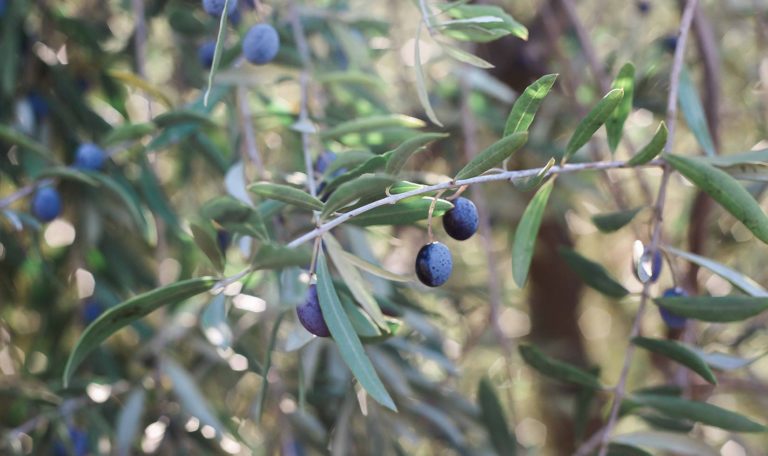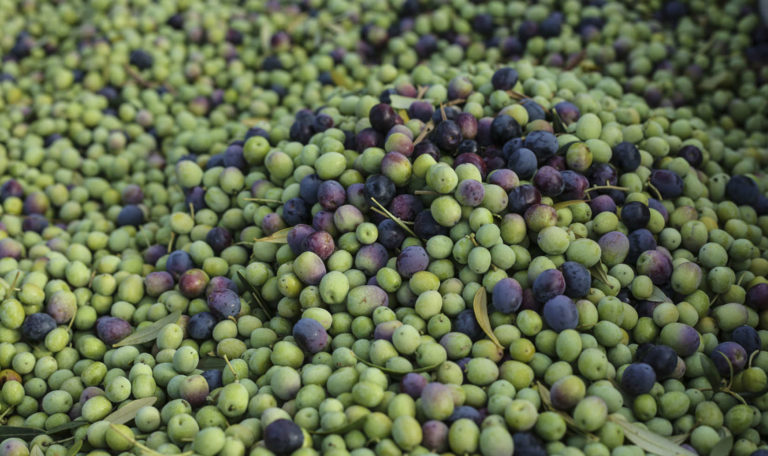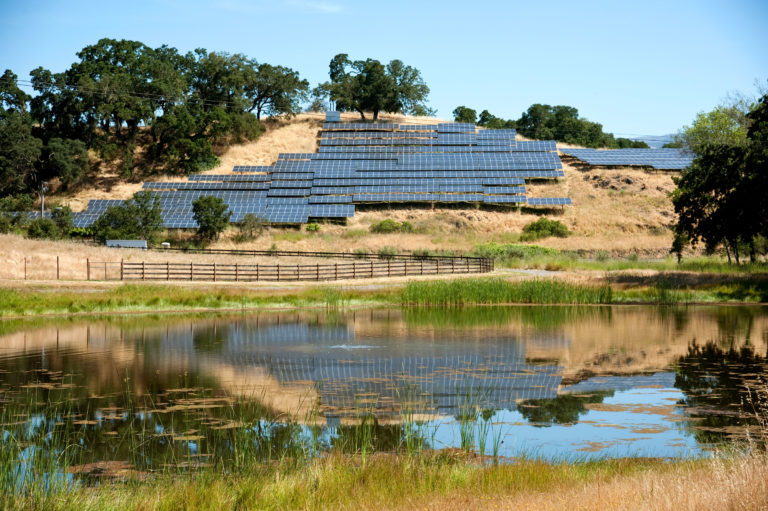Since 1997, Jordan Winery has made small-batch, high-quality extra virgin olive oil from Italian and Spanish olive trees planted on our 1,200-acre estate in Sonoma County, California. The art of how olive oil is made for extra virgin olive oil classification is different from regular “pure” or “classic” olive oil, and after the national news coverage of Italy’s extra virgin olive oil scandal, which reported that many volume producers have been exporting bottles labeled as Italian extra virgin olive oil that were not extra virgin quality (some oils weren’t even made from olives!), it’s important to understand why cold-pressed extra virgin olive oil is the best quality olive oil, and why it costs more than other classifications. In this video, we demonstrate how olive oil is made for Jordan Estate Extra Virgin Olive Oil. Read below for key steps for how to make extra virgin olive oil. Real Food for Life also has one of the best overviews on how to spot olive oil fraud, what makes extra virgin olive oil special and how to identify extra virgin olive oil.
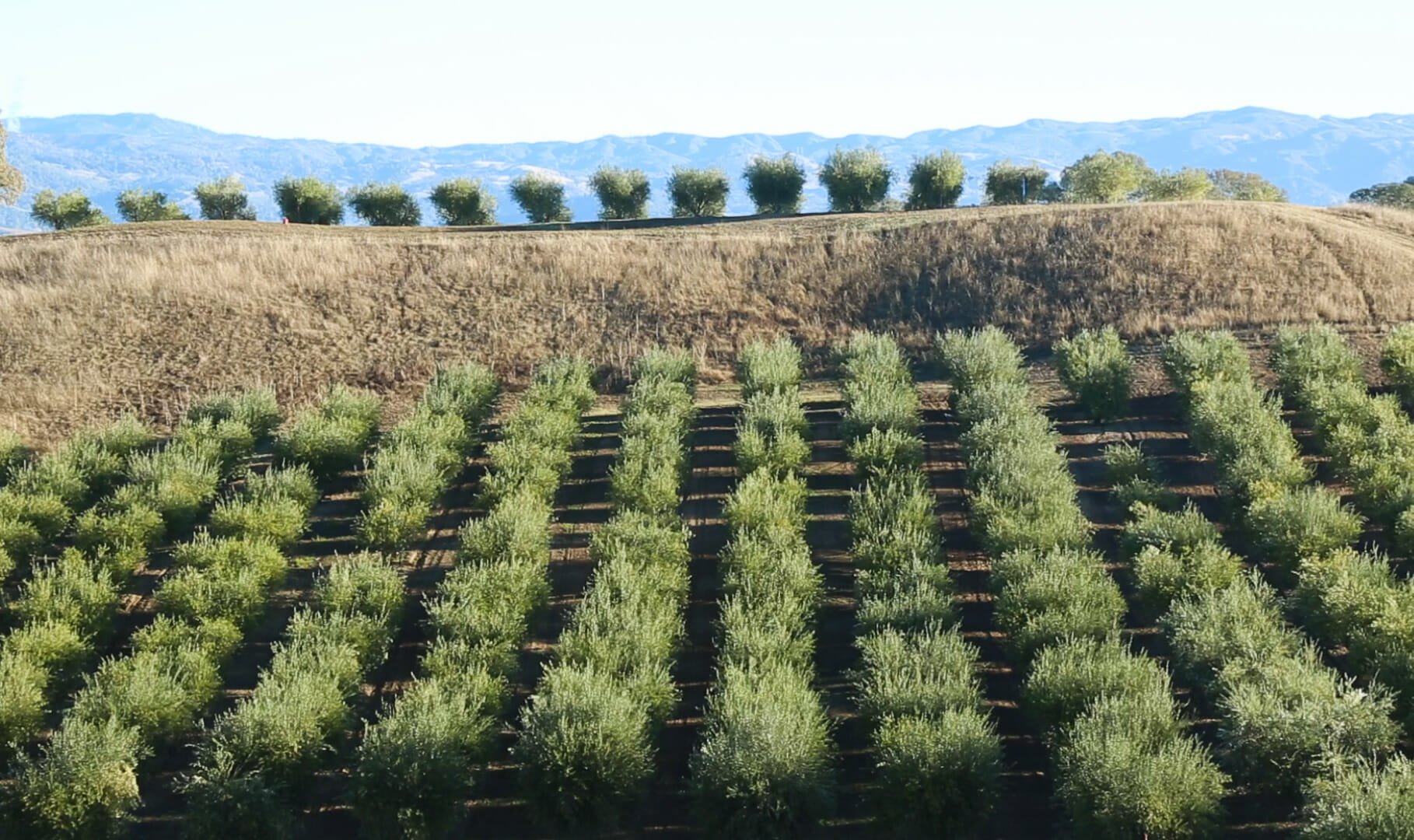
Growing Olives for Extra Virgin Olive Oil
Olive trees have been cultivated in the Mediterranean Basin of Europe for centuries. France, Italy, Spain and Greece are all known for their stalky olive trees and green-hued olive oils. These countries’ dry, warmer weather also makes it ideal for wine grapes. Unlike grapevines, olive trees are shallow-rooted, so planting in windy areas can be a problem as the trees get older. Olive trees can live for 100 years plus and begin to produce a consistently bountiful crop around the 25-year mark, in our experience at Jordan Estate. These alternate-bearing trees produce more fruit in one year than the other, so crop size is consistent, yet inconsistent.
Sonoma County wine country has a Mediterranean climate, so grapevines, olive trees and stone fruit trees are all common agricultural crops. Most Sonoma olive oil producers and Sonoma wineries that make extra virgin olive oil grow olive varieties that originated in Italy, Spain or France. Here’s a list of the main olive tree varieties planted in Wine Country.
- Frantoio (Italy)—A self-pollinating olive tree from Tuscany with medium-sized fruit that is also considered a good pollinator for other olive tree varieties. Considered one of the main ingredients in gourmet olive oils, Frantoio has a strong, slightly nutty flavor with some pungency. Nearly 4 of Jordan Winery’s 18 acres of olives are Frantoio.
- Leccino (Italy)— Another common Italian variety used in making high-quality extra virgin olive oil due to its strong flavor, this Tuscan olive tree produces small-to-medium fruit and can also be used to make cured table olives. Leccino must be planted near a pollinator, so you’ll find it near Pendolino and Frantoio at Jordan Winery, though it can also be planted near Maurino, and Picholine. Leccino produces a larger crop than its pollinators and ripens earlier. More than seven acres of Leccino are planted at Jordan Winery.
- Pendolino (Italy)—Another Tuscan olive variety that yields medium-sized fruit. Though it is self-pollinating, Pendolino olive trees yield a larger crop when planted with a pollinator, such as Leccino (used at Jordan Winery) or Maurino (used at nearby DaVero Farms). Though small in size, Pendolino olives produce a moderate amount of quality oil with a mild flavor, lower bitterness and delicate pungency. Because Pendolino is planted every few rows to pollinate the Frantoio and Leccino trees, only about 2.3 acres of Pendolino trees are planted at Jordan Winery.
- Maurino (Italy)—From the Marche region to the east of Tuscany, Maurino requires a pollinator and is often planted with Pendolino, though other pollinating olive cultivars can be used. Maurino produces a medium-sized fruit that purplish-black when fully ripe and creates a flavorful, spicy olive oil. This variety is not planted at Jordan Estate, but you’ll find it in small quantities at other Healdsburg wineries that make extra virgin olive oil, such as DaVero Farms and Ferrari-Carano. The oil is very flavorful and spicy.
- Moraiolo (Italy)—Another Tuscan olive variety found in small quantities in Sonoma County wine country, though not planted at Jordan Estate. It requires a pollinator, ripens mid-season and is often blended with other Tuscany olive olives to balance their pungent flavor.
- Coratina (Italy)—From the Puglia region in southern Italy, this fast-growing olive tree ripens late in the season and produces large fruit. Coratina is used more for its oil than table olives due to its robust peppery flavor from the high polyphenols. Requires a pollinator, such as Frantoio or Pendolino. Usually harvested as ripe as possible to avoid the olive’s natural pungent, bitter notes. These olive trees are planted at nearby Ferrari-Carano, but not at Jordan Winery.
- Arbequina (Spain)—This olive tree from Northern Spain yields small fruit that is quite aromatic with very little pungency or bitterness. The squatty trees produce an abundance of olives consistently at Jordan Estate, regardless of their alternate-bearing nature. Arbequina is a known for its rich, buttery flavors, and is an important part of the Jordan Estate Extra Virgin Olive Oil blend, with nearly 4 acres cultivated at the Healdsburg winery estate.
- Ascolano (Spain)—This prolific olive tree produces an abundance of large, light green fruit with very little bitterness. Ascolano oil is very aromatic, but the fruit produces little oil. Commonly planted in California, it’s the most cold-hardy of all the table-olive varieties. Ascolano olives are tender and must be handled with care. It requires a pollinator and should be planted with Leccino, Frantoio or Pendolino. Only a few Ascolano olive trees are planted at Jordan Estate (by John Jordan’s home), but the winery wants to increase this number in the future to make its own cured olives.
- Manzanillo (Spain)—These vigorous olive trees produce a large olive with a lot of flesh compared to other varieties. Manzanillo is the most popular table olive variety in California, as it’s used for more than making olive oil. The trees are moderately cold hardy and partially self-pollinating, though their yields increase when planted near Ascolano.
- Mission (Spain>Mexico>California)—This tree is partially self-pollinating, so it benefits from being planted next to Ascolano. When picked fully ripe, Mission olives produce an oil with buttery and tropical flavors. Mission is considered to be 100-percent Californian, though it was brought from Spain to first grow in Mexico City before making its way to the Golden State.
- Picholine (France)—B.R. Cohn Winery has a significant number of old Picholine trees, a French olive variety, planted at its Sonoma Valley estate. This French olive is one of the top three most sought-after varieties, not just for its delicious taste but also its hardy, vigorous trees that bear heavy crops regularly like the Spanish Arbequina. Picholines are elongated, light-green skinned olives with a fleshy pulp with a firm texture. Cured Picholine olives have a subtle, salty flavor. Requires a pollinator, such as Leccino or Manzanillo.
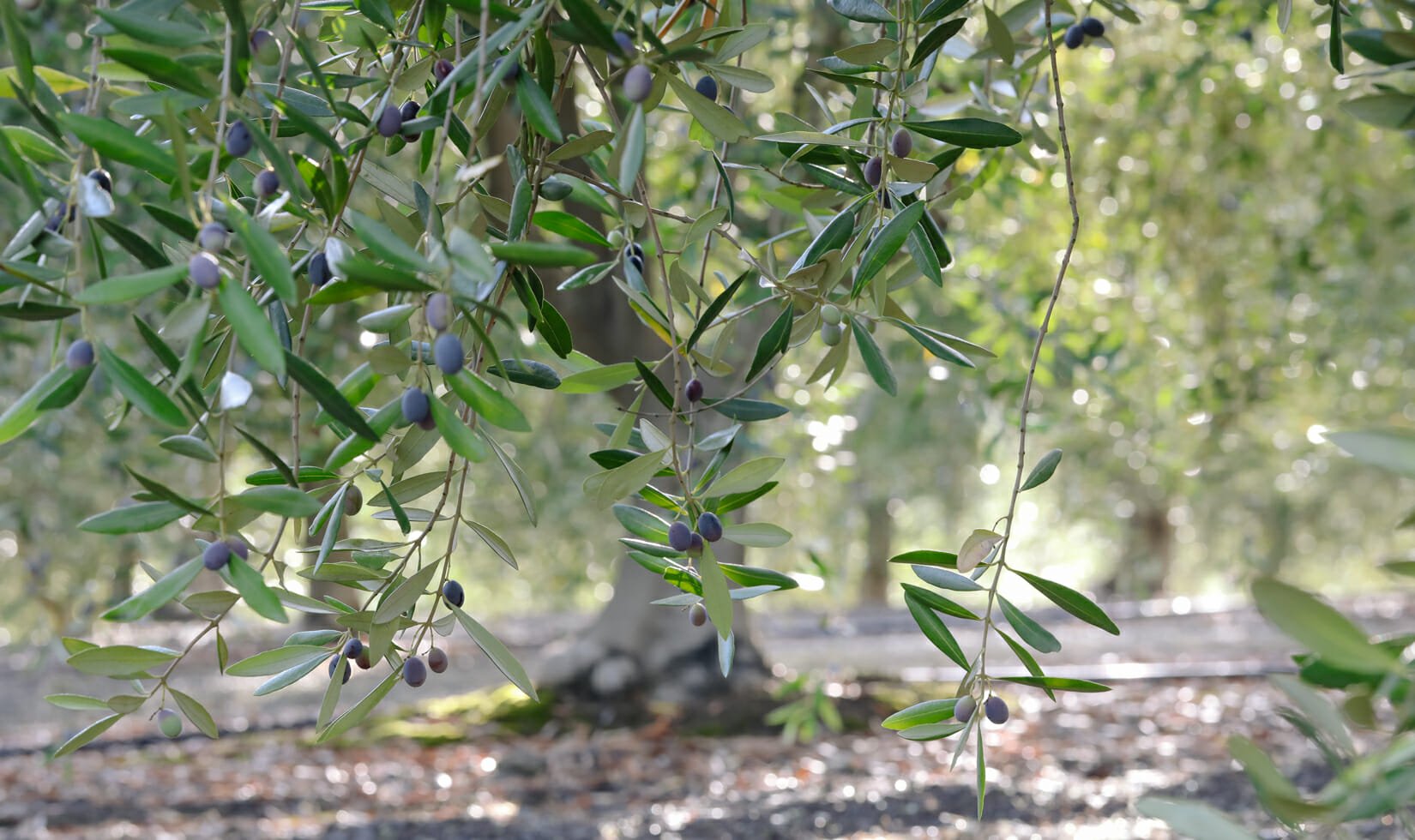
A few other tips for growing olive trees for quality extra virgin olive oil:
- According to The Olive Source, there is no precise formula for tree spacing. Olive tree planting density varies based on which type of tree you plant, but plan on planting about 100 and 220 trees per acre. How far to plant olive trees apart depends on the variety, climate, harvesting method, the typography, irrigation, soil, etc. Olive tree spacing can be as close as 3 feet by 12 feet, or as far apart as the common 28 by 28 feet. Jordan Winery trees are planted 15 x 15 feet apart. This has allowed each olive tree to develop a beautiful “open center” canopy and not shade out the lower branches. Very large Spanish olive trees, such as Manzanillo or Mission, should be planted 20 x 20 feet apart.
- Olive trees do not require a special olive tree fertilizer, but growing results will be significantly better with a good nutrition program. Olive Tree Growers is a great resource for planting and irrigating information.
- When olive trees are young, they should be watered to help them get established. Olive trees planted on clay-heavy soils at Jordan Winery are watered twice a week during the dry season; the trees are about 25 years old. Once established, olive trees are among the most drought-resistant trees in the world.
- Typical mulch and wood chips should not be used around olive trees, as they are high in carbon and steal nitrogen and other nutrients from the soil during decomposition. Mulch also holds too much water.
- Although olive trees do not require pruning to produce fruit until they are very old (more than 50 years), pruning younger trees is beneficial for shaping and allowing more light to penetrate the inner branches of the tree where fruit will grow. At Jordan Winery, we prune olive trees every 2-3 years to maintain a manageable size and height of the tree for harvesting. Otherwise, the trees will grow extremely tall and become unmanageable for pruners and olive pickers. Watch our video on how to prune an olive tree.
- First detected in North America in 1998, the Olive Fruit Fly is the main threat to Sonoma olive oil producers. This pest “stings” the surface of olives and harms the pulp, leaving it damaged for both table olives and fine olive oil. Getting rid of old fruit still hanging on trees in the fall helps reduce infestation.
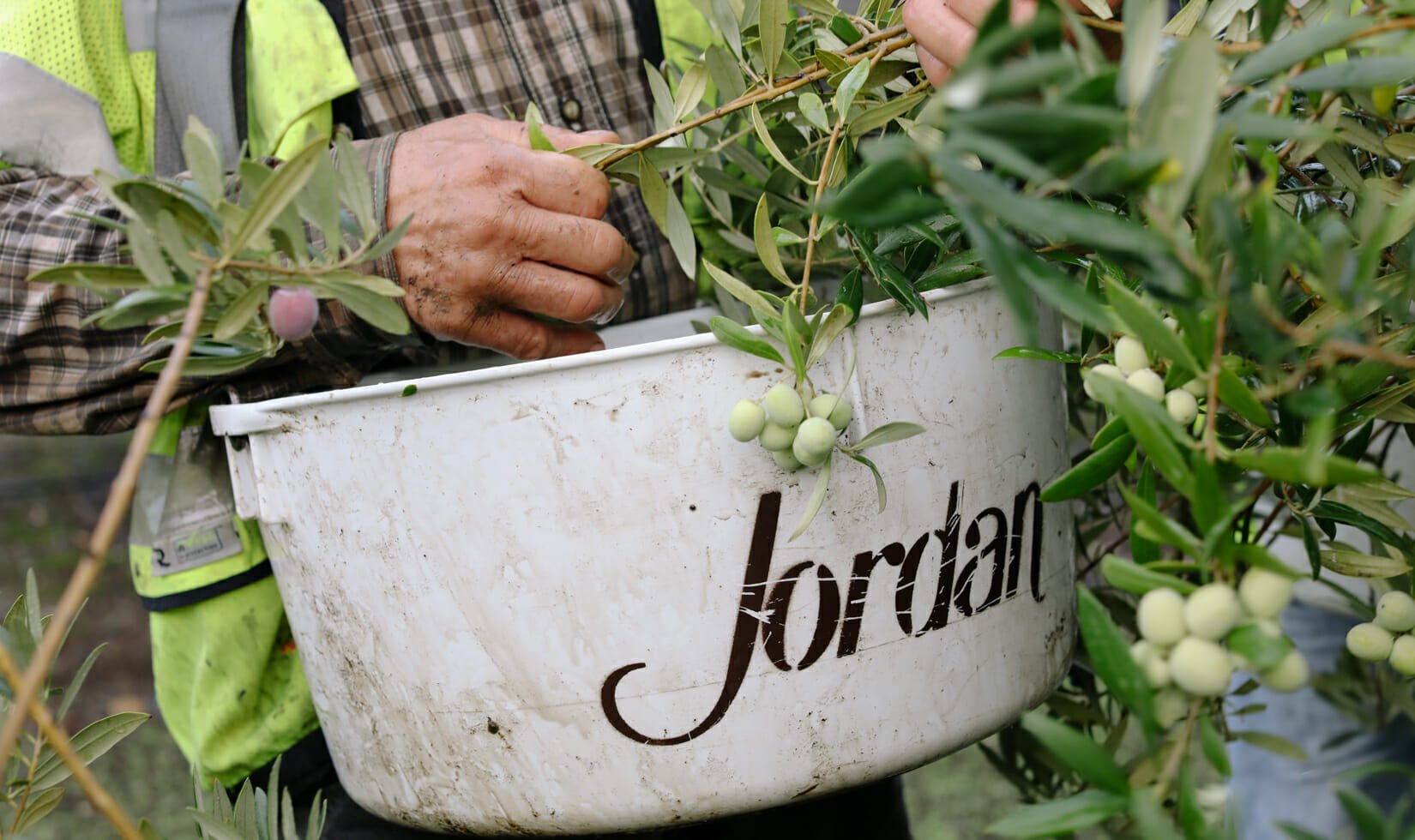
Harvesting Olives for Extra Virgin Olive Oil
- Olive harvest usually happens in Napa and Sonoma wine country in late October through late November, depending on weather conditions.
- To determine when to harvest an olive tree, use the University of California at Davis Olive Maturity Index. It’s the official Olive Maturity Index used by farmers, which ranks fruit ripeness from zero to seven. At Jordan, we prefer to pick Arbequina olives first at a lower ripeness of 1, which preserves the grassy and buttery flavors, as well as the polyphenols—one of the many health-protective antioxidants found in extra virgin olive oil. This year, we harvested Arbequinas at the optimal 1, followed immediately by Pendolino at maturity 7, where skin color is purple or black with all the flesh purple to the pit.
- Olives can be harvested in four ways: exclusively by hand, by hand with a comb, with an electric combing rake or by mechanical harvester. Jordan Winery uses all methods but mechanical, as demonstrated in past olive harvest videos.
- The Italian brucatura method of pulling the olives off the branches by-hand into a “belly bucket” is considered the traditional method, but the slowest. Using a plastic comb to pull the olives off the branches only speeds up the process a little bit. Shaking the olives out of the trees with an electric combing rake is the most efficient olive harvesting method. Workers place large, black nets on the ground to catch the olives. Next, they pull the nets to the macro bins and use a leaf blower to remove extraneous olive leaves before taking the olives to the mill.
- When harvesting olives, remove any fruit that is split, has brown dots (from the aforementioned Olive Tree Fly) or blemishes. Any diseased, frozen, or fly-infected olives should be separated and destroyed. Try to harvest before the first winter frost if possible to avoid damaged fruit.
- Harvested olives should be placed in perforated bins. Placing olives in fermentation bins or plastic bags can cause the olives to heat up and ferment.
- Depending upon ripeness, it takes about 80-100 pounds of olives to make 1 gallon of olive oil.
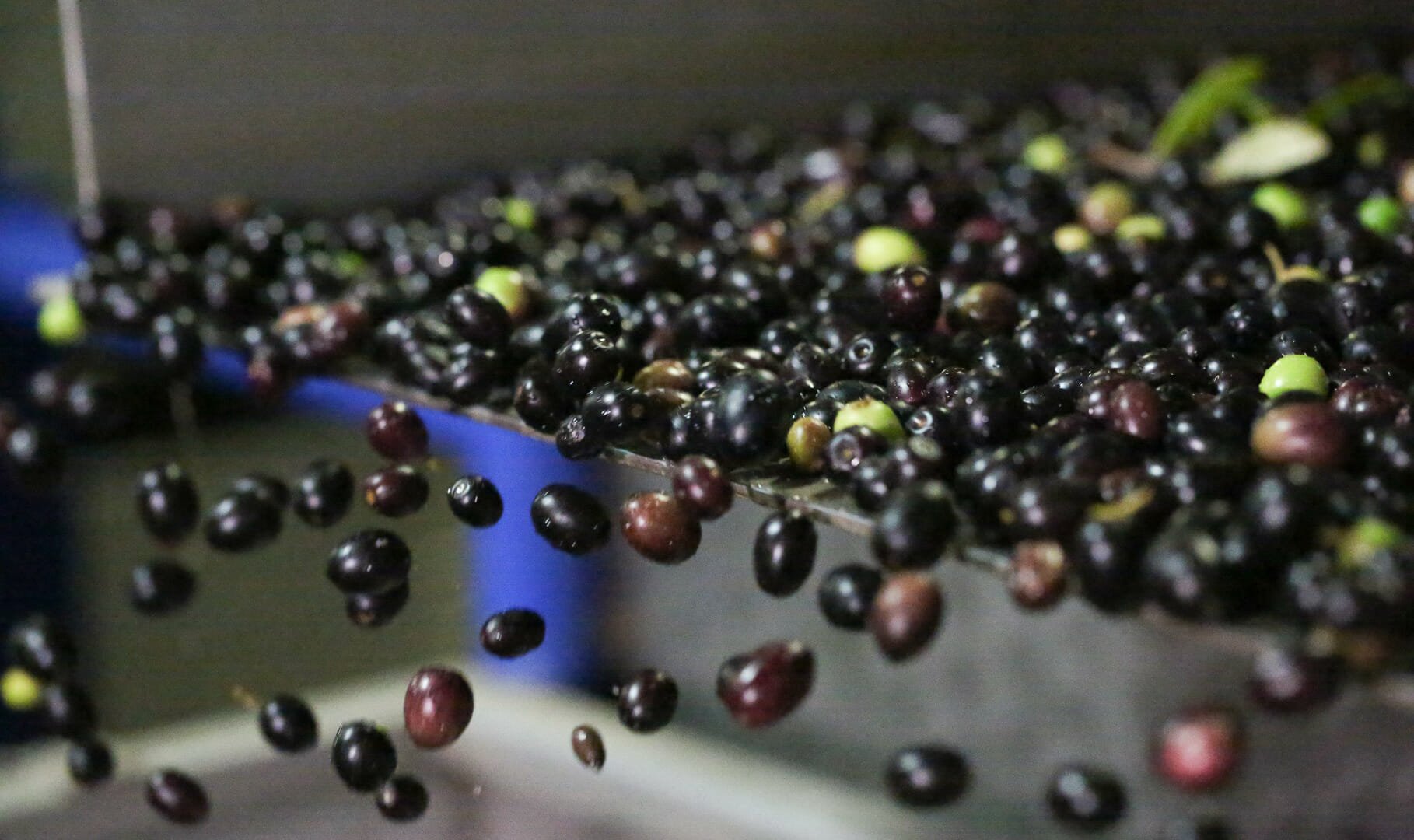
Milling Olives for Extra Virgin Olive Oil
- To be certified extra virgin, olives must be milled within 24 hours of harvest. Jordan Winery mills within 10 hours of harvest.
- Only a few wineries with larger production of olive oils have on-site olive mills at the winery, such as B.R. Cohn and Jacuzzi Winery/The Olive Press in Sonoma, and Round Pond and Longmeadow Ranch in Napa Valley. Jordan Winery, DaVero Farms and Ferrari-Carano all mill their olives at a dedicated olive mill called Olivino, located about 30 minutes north of Alexander Valley in Hopland, California.
- Some wineries mix all their olive varieties and mill them together into one blended extra virgin olive oil. Jordan Winery practiced this method until 2016, when we switched to milling all four varieties of olives separate and waiting until the blending phase to determine how much of each type we’d like to include.
- The entire milling process takes between 60 to 90 minutes. Milling olives for quality olive oil can be done one of two ways: stone milling or blade crusher. Though stone milling is the more traditional, old-world method, the blade crusher is much more efficient and thus widely used today. Stone milling takes about 20 minutes whereas a blade crusher does the same job in just two minutes.
- Olives arrive at Olivino and are sorted through the conveyor belt, removing any additional leaves.
- Olives move to 4-Batch Malaxer Tank where the crushed fruit is converted to paste in about 45 minutes.
- Oil is then separated from water in the Horizontal Centrifuge AKA Decanter for about 15 minutes.
- The Vertical Separator further isolates oil from the residual fruit water.
- Jordan Estate Extra Virgin Olive Oil rests for about four months in stainless steel barrels, allowing any sediment left to settle to the bottom of the barrels (just like winemaking). Oil stays fresh longer in drums or tanks than in bottles, so bottling does not occur until after the extra virgin olive oil has settled and master blending decisions are made.
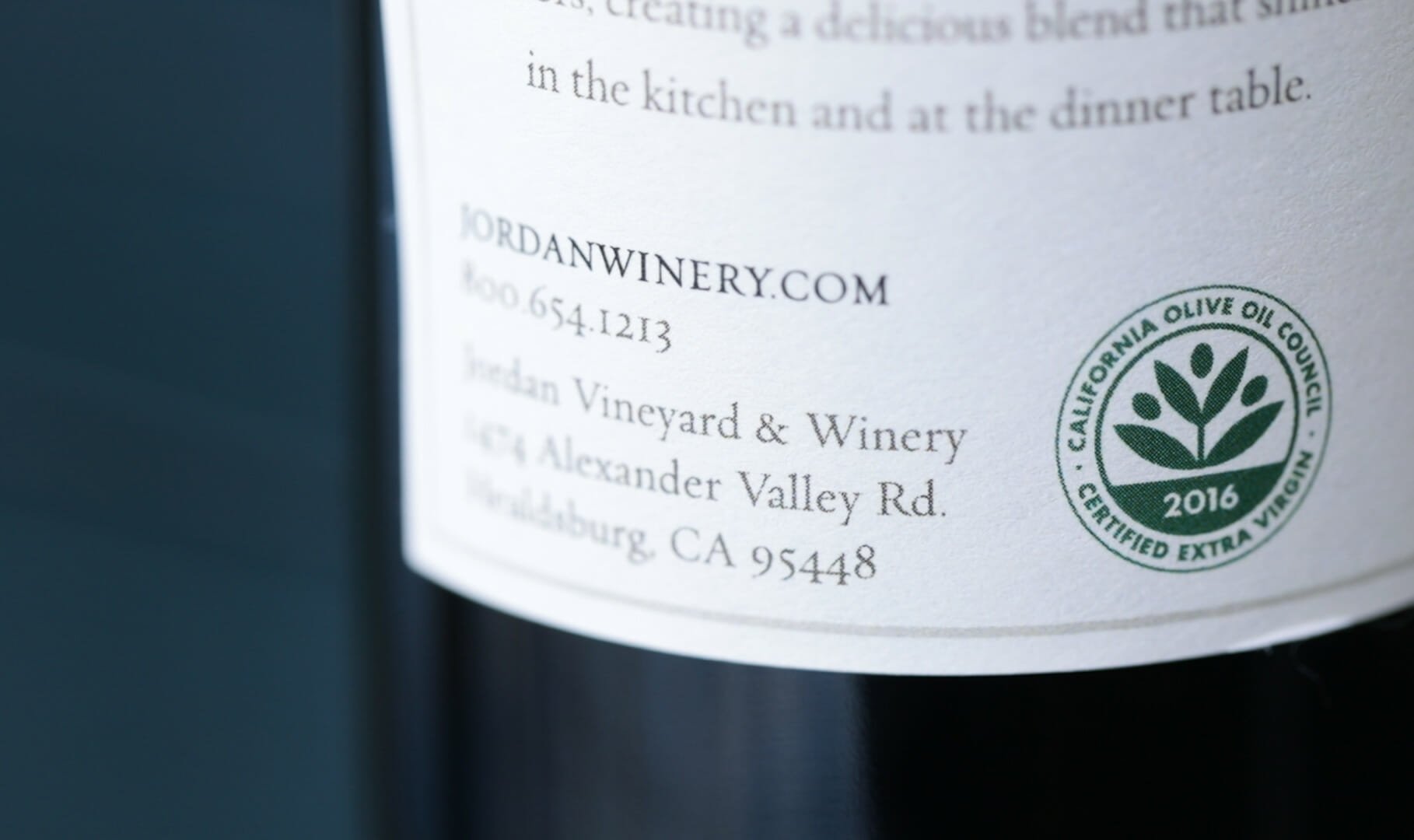
Blending and Bottling Extra Virgin Olive Oil
- One of the most critical steps in making high-quality extra virgin olive oil is determining the blend. Olive oil makers are seeking a partial style and flavor profile for their customers, and at Jordan Winery, our chef and winemaking team want to make an extra virgin olive oil that is as balanced and flavorful as Jordan wines. They blend the Spanish Arbequina with Italian olive varieties (Leccino, Frantoio and Pendolino), allowing the round, buttery Arbequina to tame the natural pungency and pepperiness in the Tuscan olive oils. Percentages vary vintage by vintage for the Jordan Estate Extra Virgin Olive Oil. (Other wineries that produce many olive oils also bottle single-varietal oils.)
- Before bottling extra virgin olive oil, the oil must be racked. Racking separates the oil from any sediment and allows the oil to retain the highest level of quality. Excess sediment in olive oil can result in shorter shelf life and lower quality. The only real exception to this is oleo nuovo, Italian for “new oil,” in which fine olive oil is bottled and sold immediately after it is made. Oleo nuovo possesses more flavor, but has a far shorter shelf life.
- Fine extra virgin olive oil is bottled in dark glass, from amber to deep green. Using dark glass minimizes light exposure to the oil, which could lead to spoilage.
- Quality extra virgin olive oils are often vintage dated. This ensures that no old oils were blended in before bottling.
- California extra virgin olive oils of the highest quality all carry the California Olive Oil Council’s seal of certification. Look for this when purchasing California olive oil.


